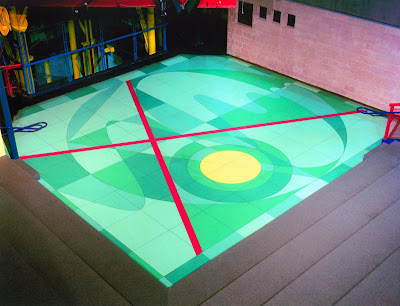 When I was hired as an exhibit designer at the Detroit Science Center in 2000, the then president Mel Drumm said "Build me an air car." I wish he asked me to produce a jet-pack, but what the hey. We were on such a short time-line (the Center's renovation/expansion project had been pushed up for the city's Tricentennial in 2001 - less than a year away with nothing yet planned) that much of our work had to be subcontracted. This was the one project I set aside for myself to execute from start to finish.
When I was hired as an exhibit designer at the Detroit Science Center in 2000, the then president Mel Drumm said "Build me an air car." I wish he asked me to produce a jet-pack, but what the hey. We were on such a short time-line (the Center's renovation/expansion project had been pushed up for the city's Tricentennial in 2001 - less than a year away with nothing yet planned) that much of our work had to be subcontracted. This was the one project I set aside for myself to execute from start to finish.The unit was to be used in hourly presentations on our "Science Stage," a 250-seat theater that was the heart of the new addition. Among other things, it would be used to demonstrate weightlessness in two dimensions. An important part of the car that never seems to be talked about - the floor. Our was a terrazzo that was flat to +/- 3/32" over 32'. The story of it's design and installation will have to wait for another post.

For the grand opening the car was a simple triangular platform of aluminum extrusions supported by three air pads that was shoved around the floor. Soon after opening, I began on the next iteration: directional jets.

As luck would have it, there was a group of gents from a local company that produced air-logic systems that were wanting to have some fun. They graciously contributed materials and expertise and time to develop a control system for the jets. Moving the joystick would apply thrust in X and Y directions, while the thumb knob would provide positive or negative rotation. Sorry - no Z.

In way of thanks, for the final installation I had a photo-anodized plaque made of their friend and company founder, Bill Carls. We placed it right on the control panel that housed the air-powered brains.
How well did it work? We were all pretty happy with the speeds achieved and the response, but if you really leaned on the jets it ate up the air faster than we would have liked. That was the limiting factor - how big of a compressor can I fit down this hole cut in the floor before it gets bricked up like a cask of Amontillado? The compressor was located in a mechanical room a couple of hundred feet way - even further as it was piped. We eliminated as many transitions in the pipe as we could to better the efficiency and installed a 200 gallon receiver tank about 50' from the car, but we could only do so much. As for the car itself, lightness was sacrificed for ruggedness. I am sure that I could have reduced the mass of the car by a third or more.
Future plans that I didn't get to before I left for Oklahoma:
Crash Land on Mars - The car would "orbit" via a tethering cable connected to a rotating hub in the center of the floor. The passenger would detach the car in an attempt to hit a foam rubber faux Mars via a tangential path. Hit = Victory! Miss = certain death.
Conservation of Angular Momentum - Using the same tether system mentioned above, the passenger would crank in the cable with a hand winch. Think ice-skater spinning and pulling in their arms. Great branding opportunity on the air-sickness bags.
I have some more images of the car and its control system. I'll add them to the post when I run across them.


